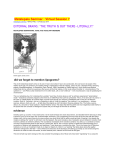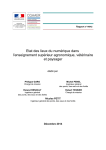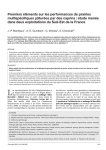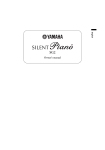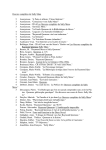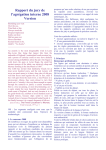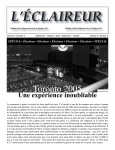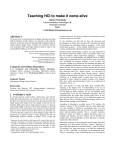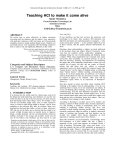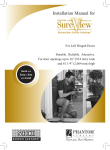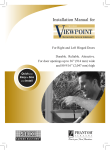Download Life A User's Manual: George Perec's Occupation of the Interior
Transcript
Life A User’s Manual Life A User’s Manual: George Perec’s Occupation of the Interior Dr Rachel Carley, Department of Design and Visual Arts, Te Whare Wananga o Wairaka, Unitec New Zealand Abstract: George Perec’s novel, Life A Users Manual (1978) focuses particular attention upon domestic artefacts that shape and influence our experience of the interior. Chapter by chapter, room by room, the novel describes a Parisian apartment building, whose façade has been peeled away to expose a cross section of the interior, leaving rooms and residents (both past and present) simultaneously visible. Perec regulates the elements to be described in each chapter: they include inventories of objects, characters, actions, and allusions to other texts. The author employs elaborate organisational principles that are analogous to a structural armature, containing his luxuriant forays into documenting the minutiae of everyday life. This paper argues that Life invites designers to take particular account of how objects occupy the interior. In the novel, objects serve to activate rooms and occupation. They serve to radically remodel and re imagine the interior, offering ways to consider how one might design an interior for occupation through the judicious study and placement of artefacts. The first section of this paper will examine the multivalent ways in which Perec inhabits the interior. The second section of the paper looks at how Perecquian stratagems can be put to work in the architecture and interior design studio and does so by reflecting upon two design studio projects. The first project, Intérieur, required students to critically examine Perec’s novel Life and design an apartment building. Throughout the paper, particular attention was placed on the ways in which the interior was wrought in an array of architectural representations. The studio was designed to foreground the interior over the objectification of building, which often results in the negation of a rich interior experience. In the second studio, Natura Morta: Architectures of Still Life, students were required to investigate how domestic objects, and the genre of still life painting in particular, could function as catalysts in the formation of innovative interior spaces. Each student conducted in-depth research into this genre, with the intention of locating its currency for contemporary spatial practice. Initial design exercises consisted of the construction and documentation of still life ensembles using a variety of media. Particular attention was paid to material selections, composition, observation, and the impact this collection of forms had on its immediate environment. This paper draws attention to the significant role objects play in the formation and occupation of the interior, highlighting how quotidian objects can be studied to excavate their spatial potential. Life A User’s Manual: George Perec’s Occupation of the Interior French writer George Perec (1936-1982) is best known for his novel Life A User’s Manual (1978). Perec spent many years laying the groundwork for his magnum opus. David Bellos has compared the composition of Life to the organization of a building contract, in which “The planning had taken years and now provided detailed instructions about the shape 1 and decoration of each room.” Ostensibly, Life describes a Parisian Apartment Building situated at 11 Rue Simon-Crubellier. The building façade has been peeled away, to Proceedings of the Conference held at the nd th University of Brighton 2 to 4 July 2009 Occupation: Negotiations with Constructed Space 1 Life A User’s Manual expose a cross section of the interior. Saul Steinberg’s drawing The Art of Living (1952) inspired the author. Steinberg’s sectional perspective depicts a boarding house in New York, replete with residents surrounded by their belongings. In 99 chapters Perec pays literary homage to Steinberg with his own elaborate sectioning of the interior in all its variegated wonder. Each chapter of Life is devoted to describing an individual room within the apartment building. Perec creates domestic tableau furnished with extraordinary interior detail. What is of particular interest in this paper is the manner in which Perec portrays each resident of each room obliquely, through the descriptions of the objects they own and the spaces they occupy. Life challenges definitions of realism in literature by utilising ‘Oulipian’ constraints. Perec was a member of OuLiPo (Ouvroir de Littérature Potentielle, or "Workshop of Potential Literature"), a group of writers dedicated to the study of literary form based on systems of rigorous formal constraint, appropriating formal patterns and strategies from domains like mathematics, logic, and chess. Captivated by word games, Perec liberally deployed palindromes, anagrams and lipograms throughout his work. The layout of the apartments within the novel makes reference to the dimensions of a chessboard, measuring ten storeys high by ten rooms wide. The sequence of the chapters has been determined by the knight’s tour of the chessboard, where the knight moves around the board landing on every square only once. This formal device serves to reinforce the disruption of narrative continuity throughout the novel. Another arcane organizational constraint Perec used involved an algorithm borrowed from higher 2 mathematics known as the "orthogonal Latin bi-square order 10". This algorithm was used to elaborate pre-established lists of fourty-two different elements, including objects, characters, situations, literary allusions and quotations, that figure in each chapter of the novel. Throughout Life, Perec also enlists Situationist strategies of détournement and collage, which involve dispersing existing texts into new formal relationships. His détournement of literature has an uncanny effect, as Bellos notes, for they create “that unique and disturbing atmosphere common to dreams, in which things seem at once familiar and 3 strange.” This is emblematized by one of Life’s central characters, Percival Bartlebooth, who was based upon two literary protagonists: Bartleby, from Herman Melville’s short story, Bartleby, the Scrivener: A Story of Wall Street (1853) and the central character from Valéry Larbaud’s novel, The Diary of A.O. Barnabooth: A Novel (c. 1913). Perec employs complex organisational principles in his novel that are analogous to some form of structural armature, which contains the author’s luxuriant forays into documenting the minutiae of everyday life. As a member of the literary group Cause Commune, he was committed to the ‘infra-ordinary’, and was closely engaged with observing and recording everyday, banal occurrences. It is precisely these banal domestic settings that Perec illuminates throughout his novel. Perec’s characters are defined through things, by the material artefacts they surround themselves with. Prior to writing Life, the author produced Things (1965), a story which uses a young couple, and their environment, as a critique of consumer society. The narrative consists of a description of the things the couple own and the objects they desire. The couple define themselves through things, but as Emerson notes, on the other hand “it Proceedings of the Conference held at the nd th University of Brighton 2 to 4 July 2009 Occupation: Negotiations with Constructed Space 2 Life A User’s Manual 4 is things that define them.” Identity formation is thereby contingent upon conspicuous consumption. Life constructs a snapshot of the apartment and its inhabitants at one moment in time. Each chapter of the novel begins with a detailed description of a room within the apartment building. Initially, a judicious selection of objects and interiors details are described, and, through these descriptions, the reader begins to learn small, personal details about the residents occupying each room. Each object has its own itinerant history that helps the reader construct a partial biography of the resident. The psychological interiors of Perec’s characters are not excavated in detail. The distancing effects of the narration are due to these indirect character descriptions. They are also a consequence of the regulatory principles Perec superimposes on the narrative. References are often made to previous tenants, who have left some residue or trace in the building. These traces lead to the telling of other stories that move outside the finite boundaries of the particular room being described, liquidating divisions between the apartment and the world outside its walls. While the novel has no specific narrator, Serge Valène, the apartment building’s longest resident offers a ‘guided tour’ of the interior. As Life proceeds, the reader is instructed that they are watching /reading the creation of a painting by Valène, a painting of the cross section of the apartment building being described. One of the central protagonists in the novel is the English millionaire Percival Bartlebooth who undertakes a Sisyphean quest that, if successful, would destroy itself as it proceeded. Bartlebooth studies watercolour painting for ten years with Valène. He then travels the world for twenty years painting five hundred seascapes in five hundred different ports. When each painting is complete he ships them to another apartment resident, Gaspard Winckler, who makes them into jigsaw puzzles. Bartlebooth then returns to his apartment and spends the next twenty years reassembling the jigsaws that Winckler has made progressively more difficult to complete. Once each puzzle is finished an ingenious chemical process is used to eliminate the seams between the puzzle pieces. The watercolour is sent back to the place where it was created and is then dipped in a detergent that eliminates all traces of the painting. No trace would remain of an endeavor that took fifty years to complete. But Bartlebooth’s project will be thwarted by his deteriorating eyesight and premature demise. Paul Auster sees Life as a parable “about the efforts of the human mind to impose an arbitrary order on the world.”5 While constraints and regulatory principles serve to rule out or at least minimize chance, death always lays waste to these mechanisms of control. Bartlebooth’s plight can be seen as a leit motif for the structure of the novel itself, which is underwritten by rigorous constraints that are ultimately abandoned by Perec as the novel draws to a close. Many tales in the book also emphasise elaborate plans and schemes that are foiled. Valene’s painting of the apartment will also remain unfinished, left as a preparatory sketch when he dies at the end of the book. Peta Mitchell, describes Life as: “An exemplary architext, self-reflexively articulating the impossibility of a totalizing architecture…the total structure fails, and the knight’s tour is rendered incomplete. Thus the novel frees the reader from the ‘tyranny of the straight line’ by positing the idea of architecture and literature as a game to be played between author-architect 6 and reader-inhabitant.” Proceedings of the Conference held at the nd th University of Brighton 2 to 4 July 2009 Occupation: Negotiations with Constructed Space 3 Life A User’s Manual Perec and his characters search for control ultimately leads to failure. Yet the spatial and material inventions he relentlessly designs throughout the novel unequivocally succeed in drawing attention to the quotidian realm. With forensic scrutiny, Perec sheds light on the myriad ways his characters experience and negotiate interior architectures of the everyday. Life A User’s Manual: Design Studio Perec’s novel lends itself to critical interrogation within both the architecture and the interior design studio. It can be argued that by drawing attention to the objects, surfaces and interior details found within rooms, the novel foregrounds what architectural education tends to disavow: a detailed study of the interior that is not limited to the diagrammatic sectioning of this space but is, rather, redolent with detail that evidences a commitment to occupying the interior itself. Perec’s novel foregrounds a particularly disturbing negation frequently encountered in the architecture studio, where a preoccupation with bulk and location studies early in the programme can lead to the radical objectification of building. This can serve to marginalise any detailed investigation into the interior of the project in negotiation with the shaping of its external skin. In recent years, I have designed two separate studio papers that were directly and indirectly influenced by Life. The first studio paper entitled Intérieur, was delivered to second year students at the School of Architecture, Auckland University in 2003. The intention was to offer architecture students an opportunity to dwell lovingly on the interior in the production of architecture. Perec’s novel was used as a vehicle to achieve this. The studio lasted twelve weeks in total. The first six weeks were spent on initial design investigations and the final six weeks on the design of an apartment building. Each student was required to read Life and critically attend to theories of interiority, paying particular attention to the ways in which the interior was wrought in an array of architectural representations. The paper attempted to supply an antidote to the object status contemporary architectures of celebrity often attain, a status ensured through representations on offer in architectural publications prone to edifying the edifice and offering only a few carefully choreographed views of the interior. Students were invited to reconsider their assumptions about where an interior might begin and end, whether external and internal conditions were mutually exclusive, or, more realistically, inseparable. They were asked to question why architect’s so frequently documented their interiors when un-populated or unfurnished. They were also were asked to consider the political dimension inherent in all forms of architectural representation, to determine what information was privileged and what information was disavowed in a range of drawing types that were used in fashioning the interior. Preliminary design exercises focused upon the categories of room, stair and section. Developing a Surface The first exercise required students to construct a developed surface drawing, selectively enumerating the contents of a room of their choice found in Life. This drawing type was used because it presents a discontinuous, fractured view of the inside, separating a room and the accoutrements found within it from its surroundings. This fragmentation of constituent domestic cells within the interior mirrors Perec’s narrative structure, which shifts from describing one resident’s room to another, disturbing diegetic continuity. Proceedings of the Conference held at the nd th University of Brighton 2 to 4 July 2009 Occupation: Negotiations with Constructed Space 4 Life A User’s Manual Fig. 1. Samuel Caradus, Morellet’s Developed Surface (Chapter 7, Servants’ Quarters 2, Morellet), 2003. This drawing (Fig. 1) by Samuel Caradus unfolds apartment 17, exploring the haphazard interior of the mad-cap inventor Morellet. Elaborate mechanical devices are extruded from the walls and floor. The charred surfaces that punctuate the room bear witness to the occupant’s unsuccessful experiments. Students were asked to consider how the developed surface drawing, as a descriptive tool, related to Perec’s style of narration. How did it dwell within and on the constitution of interior surfaces? They were also asked to consider whether Perec’s descriptive prowess flattens space, reducing it to a kernel of liminal thickness, lingering purely on surface treatments, or whether it filled space up with objects and atmospheric effects. Stair: The Poetics of Egress For the second exercise, students were required to investigate the poetics of egress, leading to the design of a staircase to connect floors within an apartment building. Perec writes: “For all that passes, passes by the stairs, and all that comes, comes by the stairs: letters, announcements of births, marriages, and deaths, furniture brought in or taken out by removers, the doctor called in an emergency, the traveller returning from a long 7 voyage.” The staircase operates as the collective space within the building. Emerson has made an analogy between Valène the painter-narrator in Life, and the stairs of the building, which 8 function as “the trustee of collective recollections.” In an apartment building egress paths act as pivot points for the chance encounter with other residents and visitors to the building. Students were asked whether they supported Perec’s claim that the use of the lift, as an expedient form of egress, had sidelined the magisterial stair, which now frequently serves primarily as an alternate escape route. They Proceedings of the Conference held at the nd th University of Brighton 2 to 4 July 2009 Occupation: Negotiations with Constructed Space 5 Life A User’s Manual were encouraged to consider the poetics of the stair, an architectural instrument activated in time and through space. They were asked to investigate how the stair negotiated between the public and private realms within the interior. They were also required to take account of the stairs acoustical properties, considering how the treads received the footfall of users: did this rite of passage announce itself or was sound stifled by a bespoke flooring surface? Consideration was also given to the representation of the stair from different vantage points: should it be drawn and modeled to be looked down into, mirroring the dizzying heights of Alfred Hitchcock’s Vertigo, or should it be viewed from beneath with the human figure dwarfed by its magnitude? This design exercise sought to endow the stair with a form of characterization that would complement its literary counterpart. Section: An interrogation of the cut and the constitution of domestic space. The third exercise required students to construct a section. By exfoliating the building envelope, the section opens the interior to detailed scrutiny, enabling access to constituent rooms, locating egress paths and exposing the covert passages taken by building services. The section has the potential to reveal what is in hiding, documenting support systems that sustain the domicile like plumbing, electrical conduit, air conditioning ducts and waste disposal units. Issues regarding the ‘cavity wall’ and interior linings (both decorative surfaces and structural prophylactics) were scrutinized. Students were asked to consider what the section exposed, concealed and rendered ‘transparent’. These exercises extended upon earlier research into the structuring of Perec’s novel. Through constructing the section, students designed an armature that would accommodate Perec’s motley crew of characters. These preliminary design studies (Room/Stair/Section) concluded with the design of an apartment building. Many of the student’s apartment proposals challenged convention, abandoning standardized room sizes and homogeneous material finishes. They sought richer variegations within their interior environments as a consequence of their earlier research and design explorations. Life’s complex method of construction and composition provided a phenomenal resource to students within the spatial design field. Perec’s stories, many imbued with a deep and abiding sense of pathos, foreground the intimacy and immediacy of interior experience. Intérieur was designed to question how we might occupy architecture. Throughout the studio, students consistently worked from the inside out, dwelling on the construction of certain critical aspects of the interior and, more particularly, its representation. Natura Morta: Architectures of Still Life Perec’s novel acknowledges that the decorative predilections of occupants can serve to radically remodel and re imagine the interior. Life offers a provocation to designers: how might one design an interior, beginning with the judicious collection, placement and representation of artefacts in space? The second design studio paper inspired by Perec’s ruminations on the interior was Natura Morta: Architectures of Still Life. The term still life (still leven) came into use in Dutch inventories around 1650 to describe a painting of a motionless model. It is only in recent years, however, that still life has been rescued from the margins of Western Art where it had been considered one of the lesser genres. Still life’s subjects are objects of mundane, precious or perishable provenance, frequently drawn from the domestic realm. The genre makes reference to generic objects independent of their users for the human figure is deliberately removed from the picture. Proceedings of the Conference held at the nd th University of Brighton 2 to 4 July 2009 Occupation: Negotiations with Constructed Space 6 Life A User’s Manual According to Norman Bryson, narrative is also deliberately removed in still life. He writes: “The law of narrative is one of change: characters move from episode to episode, from ignorance to knowledge, from high estate to low or from low to high. Its generative principle is one of discontinuity: where states are continuous, homeostatic, narrative is helpless. But still life pitches itself at a level of material existence where nothing exceptional occurs: there is wholescale eviction of the 9 Event.” On first glance, Bryson’s position regarding the absence of narrative in still life and Perec’s utilization of objects to facilitate narration appear antithetical to one another. Bryson highlights the anonymity of objects in still life; objects that spectacularly fail to generate narrative interest because they fail to be unique. In contrast, Perec’s inventories of objects are enlisted to provide his readers with indirect access to the characters in his novel. They are used precisely in order to draw attention to what is unique. Objects serve to activate rooms and the particular lives lived within them. Perec narrates through objects, assigning the demoted a narrative currency that is not evident in the still life genre. The objects within the interior collectively serve to ‘speak’ of the inhabitants, both past and present, as time and space elide within the framework of the novel. In comparison, in still life objects are represented independently from their users. Yet within Perec’s novel there is also an abiding interest in homeostasis, in things not changing, as Bryson observes about the genre of still life. This can be evidenced in elaborate stratagems (like Bartlebooth’s), which, if successfully completed, would result in a complete erasure of expenditure. Bartlebooth’s exceptional quest would conclude with nothingness, arriving at a state of equilibrium, were it not thwarted by his untimely death. Bryson’s rejection of narrative in still life painting was, to a certain extent, placed in question as the studio paper proceeded. It was discovered that a strategic assemblage of still life objects can also ‘speak’: disclosing a narrative found in the spaces between objects, a narrative mediated through the deliberate juxtaposition of carefully chosen artifacts that resonate in relation to their surroundings. In the design studio students were required to collect and compose their own still life compositions, bringing their own unique perspectives to bear on the construction and representation of still life. The still life genre continues to fascinate both artists and architects alike. Issues regarding space, scale, light, placement and profile, which have been carefully investigated in the work of still-life artists such as Giorgio Morandi, are also crucial concerns for the architect. Le Corbusier and Amédée Ozenfant produced a collection of purist still life paintings in Paris between 1918-1925. Like the Cubists’ still life paintings, Le Corbusier elected to deploy subject matter found outside the domestic realm, using items such as wine bottles and glasses in combination with newspapers, pipes, and chair caning to make reference to the public spaces of bars and cafes. Christopher Reed argues that Corbusier’s still life practice paralleled his “anti-domestic residential architecture,” de-domesticating “the accoutrements of daily life by translating them into the factories and temples his writings uphold as prototypes for the new architecture.”10 A number of more recent architects have also expressed a fascination with still life. John Hejduk compiled a number of drawings for projects devoted to accommodating the still life painter, both alive and posthumously. Aldo Rossi was a great admirer of Giorgio Morandi’s Proceedings of the Conference held at the nd th University of Brighton 2 to 4 July 2009 Occupation: Negotiations with Constructed Space 7 Life A User’s Manual still life’s, in particular the manner in which their precision led to the creation of ambiguities 11 of scale, such that humble objects gained the magnitude of “monumental buildings.” In A Scientific Autobiography, Rossi writes of his fascination with objects, recalling a time when he used to linger for hours in a kitchen “drawing the coffeepots, the pans, the bottles. I particularly loved the strange shapes of the coffeepots enameled blue, green, red; they 12 were miniatures of the fantastic architectures that I would encounter later.” Many of his drawings of typological structures also convey an ambiguity of scale that makes them easily comparable to domestic objects of everyday use such as coffee pots and tea canisters (objects which Rossi designed for the Italian manufacturer Alessi). Frank Gehry’s interest in still life composition was also highlighted in the recent film, Sketches of Frank Gehry. Students in the Natura Morta design paper were required to critically investigate the genre of still life, mining its potential for the design of innovative architecture and interior design. Precedent studies were undertaken to investigate the range of subjects deployed in still life, including vanitas (memento mori), food, and objects of daily use. Recent forays into media such as sculpture, photography and film were also introduced. Tableau: Still Life In-situ Fig. 2. Charles Sandford, Still Life Studies, 2005. Initial design exercises focused on the construction and documentation of still life ensembles, as with these pieces by Charles Sandford (Fig. 2) that explore the shadowplay of objects against a range of different surfaces to examine what aspects of an object are highlighted or obfuscated when shifts in context occur. Each composition needed to be carefully designed in relationship to its context. Students had to collect, assemble, observe and record their composition from a variety of different orientations under carefully calibrated lighting conditions. The still life was documented using a variety of media to test how different media impacted on the representation of the collection of objects. Proceedings of the Conference held at the nd th University of Brighton 2 to 4 July 2009 Occupation: Negotiations with Constructed Space 8 Life A User’s Manual Fig. 3. Sophie Wylie, Still Life Studies, 2005. Particular attention was paid to material selections, composition, observation and the impact this collection of forms had on its surrounding environment. Students studied the shadows cast by objects, the reflective, translucent, transparent or light-absorbing properties of materials, and the solid/void relationships formed between them. The nuanced intervals between elements were to be given as much consideration as the volumes themselves. Students were also encouraged to expand the field of subjects traditionally deployed in still life, investigating more transgressive tableau, as evidenced in Sophie Wylie’s watercolour studies of the underwear drawer (Fig. 3). Chronophobia: Time and the Still Life Image Figs. 4 & 5. Somer Spiers, Still Life Studies, 2004, Eva Idham, Still Life Studies, 2004. Proceedings of the Conference held at the nd th University of Brighton 2 to 4 July 2009 Occupation: Negotiations with Constructed Space 9 Life A User’s Manual Following these early explorations, students undertook a series of duration-based exercises. Joan Luckah observes that when studying his compositions of objects in space Morandi was “speculating on every effect of the light, hour by hour, day by day, until a moment arrived when the composition appeared perfect to him in ‘its spaces, hollows, distances, and intervals.’ Mature as fruit that has reached its peak of ripeness,’ as 13 Raimondi put it.” Morandi waited patiently, until he was satisfied with the spaces between his arsenal of objects. He waits for negative space to reveal itself in its most perfect form, endowing space with substantiality. For this exercise students undertook a series of time-based studies of still life. They each needed to demonstrate how duration intervened with the construction, representation, and reception of their compositions, considering how time-based media could be deployed to represent their still life. House for a Still Life Artist In the next stage of the project students designed a house for a still life artist of their choice. They were required to identify any consonances between their forays into this genre and the work of other artists, locating similarities in terms of subject matter, compositional techniques, media, or particular lighting strategies. Detailed research was then conducted into the artist’s background in addition to precedent studies of experimental housing solutions. Students were encouraged to critically examine the manifold ways design practitioners challenge our pre-conceptions about what constitutes a house, just as still life artists shed light on overlooked aspects of the quotidian realm. Students determined what particular events would be staged within their artist’s house and decided whether these events should be positioned within a single structure or a structure composed of multiple parts separated from one another. Material selections were often wedded to their earlier compositional studies. Importantly, students gave precedence to designing a space to accommodate their chosen artists collection of still life subjects. They also had to consider how openings and exterior frames of reference impinge upon the interior life of the resident. All design work was to be undertaken from the inside out, the rooms being shaped by the events taking place within them. Fig. 6. Samuel Caradus, Still Life Painter’s Complex, 2005. Proceedings of the Conference held at the nd th University of Brighton 2 to 4 July 2009 Occupation: Negotiations with Constructed Space 10 Life A User’s Manual The exterior was intended, as much as possible, to be a by-product of the interior design process. Many of the student projects questioned apriori domestic conditions and implicit (or implied) hierarchical relationships within this domain. After the house was designed students began working on their major project. The programmatic options were taken from John Hejduk’s studies into still life, meaning that the students could design one of the following: A cemetery for the Ashes of Still Life Painters, A Still Life Painter’s Complex, Still Life Museum/ Museum for Still Life, Library for Still Life’s. Each of these programmes called for spaces of contemplation, silence, and reflection, providing the opportunity to form nuanced interior conditions hewn from the careful shaping of materials and lighting in conjunction with the display of objects or their representations. Qualities of the previous studies informed this project. The Still Life Painter’s complex produced by Sam Caradus (Fig. 6) consisted of five distinct structures, all composed in cross section and slotted together. The careful and deliberate placement and orientation of these working and living spaces served to activate the space between buildings. Kim Philip’s Crematorium for Still-Life Artists and Still-Life Restoration Centre (fig. 7) composes a very careful programmatic and spatial relationship between processes of destruction and repair. Fig. 7. Kim Philip, Crematorium for Still-Life Artists and Still-Life Restoration Centre, 2005. Conclusion Occupation can be legitimate, covert or illegal. It can obfuscate and re-negotiate boundaries between public and private domains. Diverse occupations can lay claim to new ways of inhabiting the interior as Perec’s novel demonstrates. Life inspired two design studio papers that question how we might occupy architecture. Both projects were intent upon reclaiming the interior as the primary locus of design practice. The Life studio was heavily reliant upon a close reading of Perec’s text and could be criticized for taking too literal an approach, but it succeeded in highlighting the inscription of interior detail into space and drawing attention to how interiors frame objects of especial importance to the users of those spaces. Proceedings of the Conference held at the nd th University of Brighton 2 to 4 July 2009 Occupation: Negotiations with Constructed Space 11 Life A User’s Manual The Natura Morta Studio invited students to engage with spatial and material explorations drawn from the quotidian realm. The temporal dimensions of still life were examined so that students could consider the life of a building or interior in time. Objects were studied singularly and in collaboration and served as powerful catalysts for the production of spatial designs. Endnotes 1 Bellos, David (1993) George Perec: A Life in Words, p. 621. 2 Mitchell, Peta. (2004) ‘Constructing the Architext: George Perec’s Life a User’s Manual,’, p. 9-10. 3 David Bellos in Mitchell, Peta (2004), p. 7 4 Emerson, Tom (2002) ‘From Lieux to Life…,’ p. 92. 5 Auster, Paul (2002) ‘The Bartlebooth Follies’, p. 89. 6 Mitchell, Peta (March 2004) p. 14 7 Perec, George (1987) Life A Users Manual, Trans. p 3-4. 8 Emerson, Tom (2002) “From Lieux to Life…”, p. 95. 9 Bryson, Norman. (1990) Looking at the Overlooked: Four Essays on Still Life Painting, p. 61. 10 Reed, Christopher (2000) "Domestic Strife; still life," p. 52-3. 11 Carter Ratcliff’s in Morris, Adjmi & Bertolotto, Giovanni (1993) Aldo Rossi: Drawings and Paintings, p. 11. 12 Rossi, Aldo. (1981). A Scientific Autobiography, p. 2. 13 Joan Lukach in Demetrion, James T, et. al. (1981) Giorgio Morandi, p. 28. References Auster, Paul. AA Files, v 45/46, p. 88- 89. Bottero, Maria. (April 1990) ‘George Perec: Space and Language’, Abitare, no. 284 p. 204-9. Bryson, Norman. (1990) Looking at the Overlooked: Four Essays on Still Life Painting, London: Reaktion Books. Bellos, David. (1993) Georges Perec: A Life in Words, Boston: D.R. Godine. Bellos, David. (1997-8) ‘Writing Spaces: Perec in Perspective,’ Cambridge Architectural Journal, no.9, p. 11-18. Bellos, David. ‘Literary Quotations in Perec’s La Vie mode d’emploi,’ French Studies 41 (1987): 181-94. Demetrion, James T, et. Al. (1981) Giorgio Morandi, Des Moines: Des Moines Art Centre. Emerson, Tom. (2002) ‘From Lieux to Life…’ in AA Files, v 45/46, p. 92-96. Evans, Robin. (1997) Translations From Drawing to Building, London: Architectural Association Publications. Hejduk, John. (1995) Adjusting Foundations, New York: The Monacelli Press. Hejduk, John. (1995) Architectures in Love, New York: Rizzoli. Hejduk, John. (1985) Mask of Medusa: works 1947-1983, New York: Rizzoli. Mitchell, Peta. (March 2004) ‘Constructing the Architext: George Perec’s Life a User’s Manual,’ Mosaic: A Journal for the Interdisciplinary Study of Literature 37/1: 1-16. Morris, Adjmi & Bertolotto, Giovanni. (1993) Aldo Rossi: Drawings and Paintings, New York: Princeton Architectural Press, p. 11. Motte, Warren. (2004) ‘On Reading Georges Perec,’ Yale French Studies, Issue 105, p. 1-3. Perec, Georges. (1997) Species of Spaces and other Pieces. Trans. John Sturrock, London: Proceedings of the Conference held at the nd th University of Brighton 2 to 4 July 2009 Occupation: Negotiations with Constructed Space 12 Life A User’s Manual Penguin Books. Perec, George. (1987) Life A Users Manual. Trans. David Bellos, London: Harvill Press. Pollack, Sydney (dir.) (2006) Sketches of Frank Gehry, Mirage Enterprises SP Architecture Productions LLC. Reed, C. (2000) ‘Domestic Strife; still life,’ Tate: The Art Magazine, Issue 21, 52-3. Rossi, Aldo. (1981). A Scientific Autobiography. Massachusetts: MIT Press, p. 2. Rowell, Margit. (1997) Objects of Desire: The Modern Still Life, New York: Harry N. Abrams Inc. Virilio, Paul. (2002) ‘Paul Virilio on George Perec,’ in AA Files, v 45/46, p. 15-18. Proceedings of the Conference held at the nd th University of Brighton 2 to 4 July 2009 Occupation: Negotiations with Constructed Space 13














